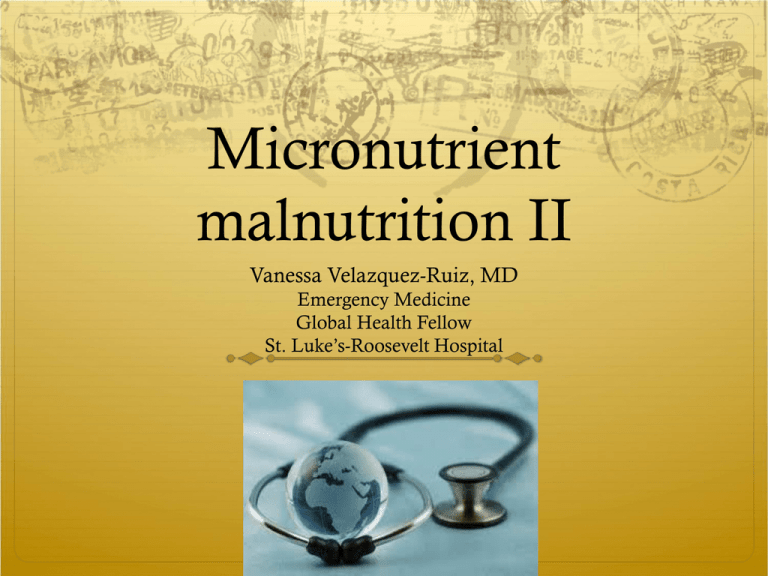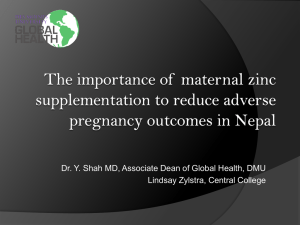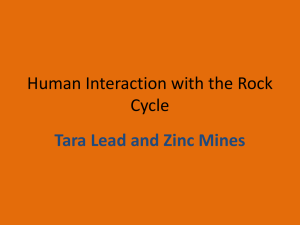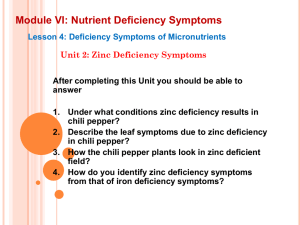Micronutrient deficiencies II
advertisement

Micronutrient malnutrition II Vanessa Velazquez-Ruiz, MD Emergency Medicine Global Health Fellow St. Luke’s-Roosevelt Hospital Today schedule…. Zinc Deficiency Iodine deficiency Lets begin the second part of our journey Are you ready!!!!!! Zinc Deficiency Common but overlooked problem in developing countries Important role in biological processes Gene expression Cell development Replication Immune function Growth and development Overview Intakes of zinc are commonly lower than recommended Adaptation mechanisms preclude the development of severe deficiencies Many consequences to adaptation states to low zinc levels Overview Probably affects a quarter or a third of pre school children and their mothers Lack of simple quantitative markers for zinc deficiency Overall, 20.5% of the world population is at risk of zinc deficiency Estimated to be responsible for 800,000 deaths/year from diarrhea, malaria, pneumonia in children under five One of the ten largest contributors to the burden of disease in developing countries Zn deficiency in world crops: major areas of reported problems (adapted from Alloway, 2008a Overview Incidence and prevalence have not been defined Lack of sensitive, practical, accepted indicators for zinc deficiency Population-based surveys have not been done Marginal deficiency is not characterized as a specific syndrome Severe clinical deficiency is not seen owing to adaptation or death Risk factors for zinc deficiency Insufficient dietary intake (low protein diet) High phytate and/or fiber intake (vegetarians) Diarrheal disease Malabsorption syndromes Parasitosis Hot, humid climate Lactation Rapid multiplicative cell growth (pregnancy, infancy, adolescence) Genetic disease (acrodermatitis enteropatthica, Sickel cell anemia) Close geographical linkage between soil zinc deficiency and human zinc deficiency Zinc Metabolism Zinc absorption Absorbed at all levels of the small intestine Intestine must recover zinc from both diet and endogenous sources Total body zinc content maintained with absorption of 5mg/day Zinc Storage No specific organ for storage 60% striated muscle 20% in bone 5% in blood and liver 3% in the skin and GI tract Zinc excretion Mostly in feces Through urine In tropical countries, sweat losses can be considerable Turnover of skin, hair and nails Menstrual blood and semen Lactation (2-3mg per day in the first several weeks) Sources of zinc Animal products, seafood, cereals Oysters and shellfish Absorption impaired by phytates and fiber. Protein acts as anti-phytate Clinical presentation Severe deficiency Growth retardation Impaired immune system Skin lesions in extremities and perioral area Hypogonadism Anorexia Cognitive dysfunction Alopecia Mild to moderate Increases susceptibility to infection Growth retardation Failure to thrive Impaired taste (hypogeusia) During pregnancy Birth defects Spontaneous abortions Fetal growth retardation Low birth weight Preterm delivery Increase complications during delivery Impairs estrogen-dependent gene expression in the uterus (via zinc-finger protein) Lack of estrogen impairs the conversion of uterus from passive state to one capable of concerted contractions with sufficient force to expel fetus Zinc and diarrheal disease Strong evidence that supplements improves the prognosis (reduces severity and duration) of children treated for diarrheal disease Zinc supplement + oral rehydration treatments been explored UNICEF recommends packs of ten tablets of 20mg Zinc/daily for tx of diarrhea Zinc and respiratory diseases Regular zinc supplements have shown to prevent respiratory diseases in children with lower birth weights Pool analysis of randomized controlled trails showed reduction of pneumonia by 41% in preschool children supplemented with zinc One trial in Bangladesh showed reduced duration of severe pneumonia by 30% with zinc as adjunct therapy Zinc and malaria Gambia: 32% fewer clinic visits for malaria due to Plasmodium falciparum in young children supplemented with Zinc 69% reduction for malaria episodes accompanied by high levels of parasitemia (>10,0000 parasites/μL) Zinc and HIV Low serum Zinc identifies in 29% of hospitalized AIDS patients Some studies showed that low zinc levels may reflect HIV replication and the possibility that Zinc may enhance viral replication, however, Daily zinc supplementation for 30 days has proven to reduce infectious disease morbidity in AIDS patients in other studies http://www.zincsaveskids.org/ http://www.youtube.com/watch?v=vN_qQPxPK3Q Assessment Plasma and Serum Zinc concentration Circulating zinc less than 0.2% of total body Cut-off values to assess risk of zinc deficiency Below 10.71 μmol/L for fasting sample and less then 9.95μmol/L for non fasting Dietary assessment Food intake distributions of a population Analysis of local staple foods Recall of an individual for food consumed Weighed food records by research assistants 24-hr dietary recall Local food composition tables if available Other Hair zinc concentrations Diminished taste acuity (hypogeusia) Composite index for predicting the national risk of zinc deficiency- uses a combination of stunting rates and adequacy of zinc in the national supple Replacement and treatment Table 1: Recommended Dietary Allowances (RDAs) for Zinc Age Male Female Pregnancy Lactation 0–6 months 2 mg* 2 mg* 7–12 months 3 mg 3 mg 1–3 years 3 mg 3 mg 4–8 years 5 mg 5 mg 9–13 years 8 mg 8 mg 14–18 years 11 mg 9 mg 12 mg 13 mg 19+ years 11 mg 8 mg 11 mg 12 mg * Adequate Intake (AI) Recommended nutrient intakes (RNIs) for dietary zinc (mg/day) to meet the normative storage requirements from diets differing in zinc bio-availability Treatment To combat zinc deficiency, five intervention strategies can be used: Supplementation using medicines Food fortification through the incorporation of zinc additives in food Dietary modification/diversification Genetic biofortification through plant breeding Agronomic biofortification through zinc fertilization. Iodine deficiency Overview Iodine is an essential constituent of the thyroid hormones (T4, T3) Deficiency can lead to Goiter or cretinism depending on the severity The ongoing global health effort to eliminate iodine deficiency through iodization of salt presents one of the largest public health efforts By 1990, there were 1,572 million people worldwide consuming inadequate amounts of iodine Iodine deficiency is the leading cause of mental retardation in the world Problem is global, with mountainous regions and large river deltas the most well-known areas of endemic deficiencies Epidemiology Mountainous areas, high altitude and alluvial plains Leaching of iodine form the soil due to erosion and heavy rain, deforestation, overgrazing lead to loss of iodine form soil and water WHO Region Proportion of population with UI < 100 µg/L (%) Africa 42.6 Americas 9.8 South East Asia 39.8 Europe 56.9 Eastern Mediterranean 54.1 Western Pacific 24 Total 35.2 Population with UI < 100 µg/L (millions) 260.3 75.1 624 435.5 228.5 365.3 1988.7 192 WHO Members States Based on population estimates for the year 2002 (United Nations, Population Division, World Population Prospects: The 2002 Revision) WHO 2003 Risk factors Residency in an area where soil and water are poor in iodine Ingestion of substances known as “goitrogens”( found in vegetables and fiber) that can interfere with metabolism Cabbage, sweet potato, brussel sprouts, turnips Cassava containing high concentration of thiocyanates Role of iodine in biological functions Metabolism Growth and development Synthesis of growth hormone Normal bone cell growth and development Brain development Early growth and differentiation of the brain and nervous systems in the fetus Immune function Sources of Iodine Seafood and seaweed Crops grown on iodine rich soil Iodized salt Drinking water (less than 10%) WHO recommended dietary requirements Spectrum of iodine deficiency disorders Fetus Abortions Stillbirths Congenital anomalies Increase perinatal mortality Neurological cretinism: mental deficiency, deaf-mutism, spastic diplegia, squint Myxoedematous cretinism: dwarfism, mental deficiency Spectrum of iodine deficiency disorders Neonate Neonatal goiter Neonatal hypothyroidism Spectrum of iodine deficiency disorders Child and adolescent Goiter Juvenile hypothyroidism Retarded physical development Spectrum of iodine deficiency disorders Adult Goiter Hypothyroidism Impaired mental function Iodine-induce hyperthyroidism Goiter Enlargement of thyroid gland in response to insufficient iodine intake Low iodine -> decrease T4 -> increase production of TSH -> stimulates hyperplasia of the thyroid -> increase uptake of iodine -> Goiter Definition by palpation: enlargement of the thyroid such that lateral lobes are larger than the terminal phalanx of the thumb of the person who is being examined Goiter Severity of goiter correlates with severity of the deficiency In areas of endemic goiter , the daily intake is less the 100 μg/day Cretinism Usually found where the prevalence of endemic goiter is more than 30% Characterized by mental retardation Two extreme types of cretinism: Neurological Myxoedematouse Myxoedematous cretinism (hypothyroid cretinism): severe growth retardation, mental retardation not severe, coarse, dry skin, husky voice. Neurological cretinism: stature is normal, mental retardation is severe, deaf-mutism, cerebral diplegia Assessment of iodine status Urinary iodine Most useful/reliable indicator I status 24hr or random (30 samples) urine collection Related to recent dietary I intake Adequate 100-200 μg/L Mild deficiency 50-99μg/L Moderate Deficiency 20-49μg/L Severe Deficiency Less than 20μ/L Assessment of iodine status Thyroid size (goiter surveys) Palpation Ultrasound (more reliable) “Total Goiter Rate”, schoolchildren Classification for Goiter Grade 0 No palpable or visible goiter Grade 1 Palpable mass but not visible when neck in normal position Grade 2 Visible, palpable swelling of the neck Goiter by palpation or by thyroid volume by US (>97% of percentile) Mild 5-19.9 Moderate 20-30 Severe >30 *School-children TSH screening programs For early detection of congenital hypothyroidism Useful epidemiology information, not cost effective The degree of iodine deficiency can be evaluated on the basis of the frequency of neonatal blood TSH above the cutoff point of 3μU/ml Mild deficiency TSH 3-19.9 Moderate deficiency TSH 20-40 Severe deficiency TSH > 40 Prevention Iodized salt: “Universal salt iodization” (150μg of I/day) Oral iodide oil Adult : 1ml (480mg) 0.5ml (240mg) Iodized oil injections Prevention Other: Iodization of drinking and irrigation water Iodine saturated silicon matrices placed in wells and hand pumps Fortification of food Conclusion Iodine deficiency is the leading cause of preventable mental retardation Great progress in providing access to iodized salt WHO/UNICEF/ICCIDD report in 1999, from 5 billion people living in counties with iodine deficiencies, 68% now have access to iodized salt. From 130 counties, 104 have intersectoral coordination and 98 have legislations about iodized salt Much work needs to be done… To be Continued… Stay tune for more on micronutrient deficiencies next week… same channel, same time Thanks Any questions… References WHO website







